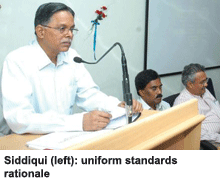A massive cohort — almost equivalent to 10 percent of the national teachers community countrywide — of 510,000 teachers is likely to be recruited and inducted into India’s 1.2 million primary and upper primary schools within the next three years to meet the 1:30 teacher-pupil norm mandated by the Right to Free and Compulsory Education Act, 2009 (aka RTE Act) which came into force in April 2010. This number is greater than the combined annual intake capacity of the country’s teacher training institutes. Therefore, educationists and academics are concerned about the probability of a massive number of untrained teachers entering the profession.
In accordance with the provisions of s.23 (1) of the RTE Act, on August 23 last year the National Council of Teacher Education (NCTE) issued a notification prescribing minimum qualifications for teachers in elementary education (classes I-VIII). In this notification NCTE made clearance of its teacher eligibility test (TET) mandatory for all new teachers with effect from the current academic year.
Last month (February 11) in a follow-up to its August 23, 2010 notification, NCTE issued guidelines to all state govern-ments and Union territories for conducting TET. Comments Prof. Mohammad Akhtar Siddiqui, chair-person of NCTE, explaining the rationale of the guidelines: “We need to have uniform national standards and benchmarks of teacher quality in the recruitment process and induce teacher education institutions to improve their performance standards. The design and structure of the test will be uniform across the country, but the content and language will be regional.”
 According to Siddiqui, the minimum eligibility criterion to write TET is completion of Plus Two and a diploma/degree in education from a recognised teacher training institute. TET will be of 90-minutes duration with 150 multiple choice questions. The guidelines prescribe separate papers for teachers aspiring to teach primary (classes I-V) and upper primaries (classes VI-VIII). Duly qualified teachers wishing to teach across classes I-VIII will have to pass both papers.
According to Siddiqui, the minimum eligibility criterion to write TET is completion of Plus Two and a diploma/degree in education from a recognised teacher training institute. TET will be of 90-minutes duration with 150 multiple choice questions. The guidelines prescribe separate papers for teachers aspiring to teach primary (classes I-V) and upper primaries (classes VI-VIII). Duly qualified teachers wishing to teach across classes I-VIII will have to pass both papers.
For some states, including Haryana, Gujarat, Madhya Pradesh and Chattisgarh which have already devised teacher eligibility tests, it will mean realignment of their tests. But the new norms are likely to create problems in polls-bound West Bengal, which was directed last year by the Union HRD ministry to amend its rules for recruitment of primary school teachers when it advertised 58,000 teachers posts in primary schools specifying the minimum eligibility criterion as class X certification. However teacher recruits from states with poor teacher training facilities have been given the leeway to pass TET within five years.
Dr. T. Geeta, senior faculty at Delhi University, questions the rationale of imposing TET upon teachers duly qualified and certified by teacher training colleges. “Why does NCTE expect wonders from TET which is a very elementary test?” she asks.
Indeed academics in the national capital are of the opinion that it’s reckless licensing and affiliation of teacher training colleges by NCTE and the quality of training they provide to aspiring teachers which is the root problem. “The remedy is not to test already qualified teachers but for NCTE to monitor the academic rigour and curriculums of teacher training colleges. If the goal is to attract the best and brightest into the teaching profession, NCTE should incentivise rather than disincentivise teachers by over-testing. This is an ill-conceived directive of NCTE,” says an academic who prefers to remain anonymous.
In short, instead of undertaking the more difficult task of improving and upgrading the country’s 8,000 teacher training colleges haphazardly licensed by it, the mandarins of NCTE have imposed another — by all accounts cosmetic — test on the teachers’ community. That’s the easier option.
Payal Mahajan (Delhi)